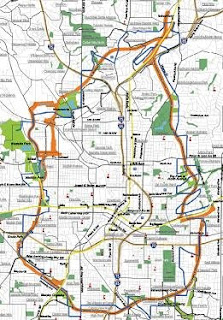Opponents of high-density, transit-oriented developments (TODs), often claim they create more of a traffic problem than they solve. But new research shows the number of trips they create is often exaggerated by as much as 50%.
First, a little background. Transportation planners struggle with how to reliably predict the number of net vehicle and person trips generated by new or infill mixed-use development such as TODs. Since the old model has relied primarily on single-use, free-standing sites, it is very difficult to make predictions with any certainty. Add to the mix internal capture rates, and the level of uncertainty rises.
The Institute of Traffic Engineers (ITE) is the only one to suggest a framework for establishing a data collection procedure for estimating multi-use trip generation to include internal capture rates. However, this framework is based on even more limited information than the old model. Currently, "...so little information is available about internal capture rates that traffic impact studies for mixed-use developments become little more than exercises in speculation." (Ewing, R., M. Deanna, and S.C. Li, Transportation Research Record 1518, pp. 1-6).
New research recently completed for the Transit Cooperative Program seems to confirm the disconnect between the modeling and the actual demand. The research confirms that the ITE trip generation and parking generation rates over estimates automobile trips for TOD developments by as much as 50%.
To view the actual study go to the TCRP website or check out this synopsis from on Planetizen.
Tuesday, February 17, 2009
Monday, February 2, 2009
GDOT fantasy threatens to scuttle BeltLine reality

There they go again, flexing their muscle instead of their brains. GDOT has built roads in the same fashion for the past 100 years in Georgia, and now they are bringing the tactic to alternative transportation. It appears GDOT wants to grab a piece of the BeltLine for their commuter rail/high speed rail fantasy with no regard to the City of Atlanta and their plans for the Beltline.
Jay Bookman writes in the AJC that the DOT does not have a good record of following through on its commuter rail plans.
Jay Bookman writes in the AJC that the DOT does not have a good record of following through on its commuter rail plans.
For example, an environmental assessment of a downtown multimodal station was completed back in 1995, the same year DOT completed its so-called “Commuter Rail Plan Final Report.” But nothing has happened to make those plans real.If only GDOT's ambitions for alternative transportation were the same as for building roads, hen we might have a world class transportation system in no time.
In fact, an $87 million federal appropriation for commuter rail between Atlanta and Lovejoy has been sitting untouched for more than five years, awaiting matching money from the state that has never come.
Subscribe to:
Posts (Atom)